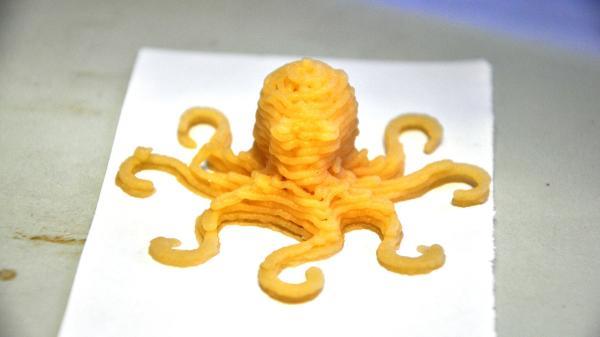Everyone needs food, the researchers point out, so the potential market for 3D printing it is a huge one. Safety concerns have to be taken into consideration, of course, and there are challenges in 3D printing food into self-supporting structures that maintain their shape. The researchers pose three questions in the paper:
- What additive manufacturing technologies are currently applied for the 3D printing of food?
- What materials are being used to 3D print food?
- What companies are active in the process of 3D printing food and how do they compete?
Several different methods are used to 3D print food. Selective sintering, according to the researchers, “can generate multiple layers of a food
matrix with each layer containing different food material components.” Selective hot air sintering and melting (SHASAM) use a beam of hot air to selectively fuse together sugar powder.
“Selective sintering offers the freedom to quickly build complex food items in a short time without post curing,” the researchers state. “This technology however, is complicated as there are many variables involved.”
Liquid binding or binder jetting is another method of 3D food printing. 3D Systems‘ ChefJet 3D printer is an example of this technology, which is faster and cheaper (in terms of materials) than other methods, but also suffers from rough surface finish and high machine cost.
Hot-melt extrusion is used for liquids or pastes. In this method, the material is heated slightly above its melting point, extruded, and solidifies immediately after extrusion, sticking to the previous layers. Soft-materials extrusion has also been used at room temperature for foods like dough, meat paste and processed cheese.“Food printing based on material extrusion generally feature a compact size, and low maintenance cost,” the researchers state. “But, there are also some imperfections that need further improvement, such as the seam line between layers, a long fabrication time, and delamination caused by temperature fluctuation.”
Inkjet printing or material jetting can also be used to create digital images as decorations or surface fill. The researchers also mention the bioprinting of meat to produce food without slaughtering animals, but so far this has been highly expensive.
 Materials used in 3D food printing include sugar, chocolate, cheese, cereals, fruits, cookie dough and ground meat. In terms of companies offering food 3D printers, the study points to 14 of them, each offering a highly specialized type of printer. These companies are listed in the table to the right.
Materials used in 3D food printing include sugar, chocolate, cheese, cereals, fruits, cookie dough and ground meat. In terms of companies offering food 3D printers, the study points to 14 of them, each offering a highly specialized type of printer. These companies are listed in the table to the right.
“3D food printing is becoming an important technology for food production and with important implications such as the ability for customized food design and personalized nutrition,” the researchers conclude. “However, its current impact is still limited as it is viewed as complimentary to traditional food manufacturing. There are also only limited varieties of food items that can be printed through 3D printers. Consumer preferences in taste, quality and culture factors might also play an important role.”
Authors of the paper include Harm-Jan Steenhuis, Xin Fang and Tolga Ulusemre.
Discuss this and other 3D printing topics at 3DPrintBoard.com or share your thoughts below.
Subscribe to Our Email Newsletter
Stay up-to-date on all the latest news from the 3D printing industry and receive information and offers from third party vendors.
You May Also Like
3D Printing News Briefs, April 27, 2024: Research, Digital Dentistry, Cycling, & More
We’re starting today’s 3D Printing News Briefs with some research into 3D printed luminescent quantum-dot polymer architectures and free-form laser beam shaping, and then on to an open source 4-axis...
HP & INDO-MIM Collaborate to Boost Metal 3D Printing in India
HP Inc. and INDO-MIM, a US- and India-based supplier of metal injection molding (MIM) powders and contract manufacturer, have announced that the two companies will collaborate to accelerate additive manufacturing...
3D Printing News Briefs, February 17, 2024: Shot Blasting, Service Bureaus, & More
In today’s 3D Printing News Briefs, we’re starting out with post-processing, as SKZ Würzburg is using a shot blast system from AM Solutions for its research. Moving on to business,...
3D Printing News Unpeeled: Not That Kind of Organ 3D Printing
GKN Aerospace will create a 150 jobs in Trollhattan Sweden with an investment of $60 million part of which comes from the Swedish Energy Agency’s Industriklivet initiative. The investment will...
































